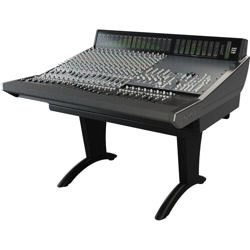Loading ...
Loading ...
Loading ...

ORIGIN User Guide
Origin Master Section
29
TALK ALL
TALK ALL is a grouped 'TALK' function. Typically this simultaneously activates the TALK function for all three communications
destinations. This is a momentary switch with an automatic latch feature (see previous paragraph). If it is pressed briey it will 'latch'
on until pressed again. The TALK ALL function is also programmable, holding down the TALK ALL switch and simultaneously
pressing a TALK switch (or LISTEN, or SEND LISTEN TO TALKBACK switches) will link or unlink the TALK function (and/or the
others) to the TALK ALL switch. This setting is remembered by the console even when the console is powered down.
The DIM function is not directly connected to the TALK ALL function. DIM will be activated if any of the functions connected to
TALK ALL have a DIM function attached.
LISTEN
The LISTEN switch switches the Listen Mic input into the control room monitoring. The Listen Mic input connection and gain
controls are detailed later in the guide (page 29). Typically, the Listen Mic is an omnidirectional mic (or mics) located centrally on
the studio oor (e.g. mounted on the ceiling). The Listen Mic Input is connected to the Listen Mic Compressor (LMC). The LMC
circuit is designed to allow a microphone connected to the Listen Input to maintain similar level signals regardless of whether the
source is close or distant. i.e. if an artist is close to the microphone and another artist is distant from it, the Listen Mic and LMC
will allow the control room to hear both artists legibly and at a similar level. This is a momentary switch with an automatic latch
feature, i.e. if it is pressed and held it will act momentarily (i.e. switch off when released), if it is pressed briey it will 'latch' on until
pressed again.
The LISTEN function can be connected (or disconnected) to the TALK ALL function by pressing and holding the TALK ALL switch
and simultaneously pressing the LISTEN switch. When the TALK ALL switch is released, the LISTEN switch will now be linked to
it. Repeating this operation will unlink the function.
SEND LISTEN TO TALKBACK
This feature connects together the Talkback and Listen Mic signals to allow a simple 'conference' system. This can be useful where
the Listen Mic is a convenient way for all artists in the session to talk to each other. For example, a session with musicians on the
Studio Floor, some in the Control Room and others in Isolation Booths. Using the Listen and Talkback features with SEND LISTEN
TO TALKBACK feature enabled would allow everyone to converse with one another.
CAUTION: If this feature is used with a listen mic in the same room as the talkback destination (e.g. studio loudspeakers, or loose
headphones), there is potential for feedback/howlround from the combination of the Listen Mic, TALK button and the STUDIO
output.
SWITCHED EXT TB (External Talkback) OUT
When pressed, this sends the Talkback amplier output directly to the DB-25 connector on the rear of the console (and potentially
then to a patchbay, if one is connected). This is useful when you want to use the Talkback circuits to feed external devices such
as a third party artist cue mix system. This is a momentary switch with an automatic latch feature, i.e. if it is pressed and held it will
act momentarily (i.e. switch off when released), if it is pressed briey it will 'latch' on until pressed again.
The Switched External Talkback function can be connected (or disconnected) to the Talk All function by pressing and holding the
TALK ALL switch and simultaneously pressing the SWITCHED EXT TB OUT switch. When the TALK ALL switch is released, the
SWITCHED EXT TB OUT switch will be linked to it. Repeating this operation will unlink the function.
SLATE
When pressed, this momentary only switch sends the Talkback signal directly to the all of 16 track Bus Outputs and to the main
stereo Mix Bus Output, replacing the signals that are feeding those outputs and CUTting the Main Monitor. Traditionally this function
was used to place a 'take marker' (e.g. "This is Take 1") onto the recorder attached to the Bus and/or Mix console outputs.
A block diagram of the communications section is shown on the next page.
Loading ...
Loading ...
Loading ...
